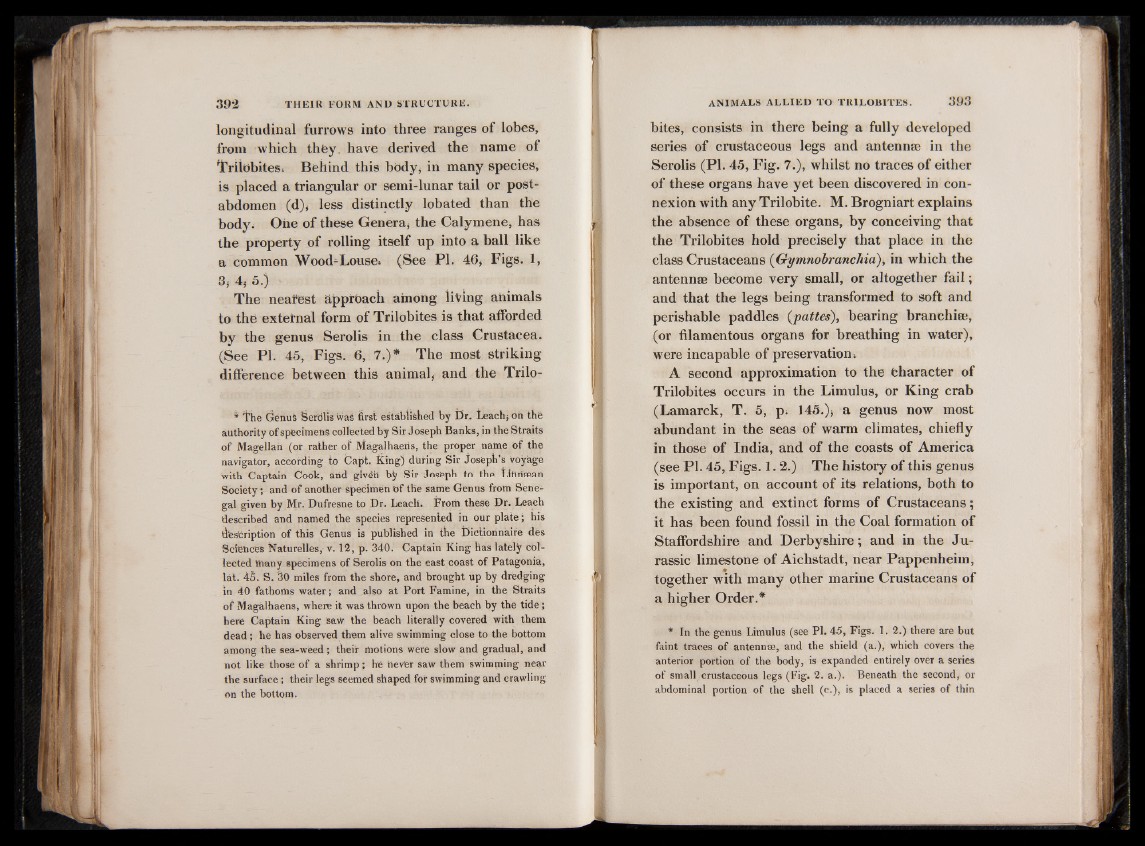
longitudinal furrows into three ranges of lobes,
from which they, have derived the name of
Trilobites; Behind this body, in many species,
is placed a triangular or semi-lunar tail or postabdomen
(d)* less distinctly lobated than the
body. One of these Genera* the Calymene, has
the property of rolling itself up into a ball like
a common Wood-Louse» (See PI. 46* Figs. 1,
3*4*5.)
The nearest approach among living animals
to the external form of Trilobites is that afforded
by the genus Serolis in the class Crustacea.
(See PI. 45, Figs. 6, 7.)* The most striking
difference between this animal* and the Trilo-
* The Genus feerctlis was first established by Dr. Leach* Oil the
authority of specimens collected by Sir Joseph Banks, in the Straits
of Magellan (or rather of Magalhaens, the proper name of the
navigator, according to Capt. king) during Sir Joseph’s voyage
with Captain Cook, and given by Sir Joseph to the Littnieean
Society; and of another specimen Of the same Genus from Senegal
given by Mr. Dufresne to Dr. Leach; From these Dr. Leach
described and named the species represented in our plate; his
description of this Genus is published in the Lictionnaire des
Sciehces Naturelles, v. 12, p. 340. Captain King has lately collected
many specimens of Serolis on the east coast of Patagonia,
lat. 45. S. 30 miles from the shore, and brought up by dredging
in 40 fathoms water; and also at Port Famine, in the Straits
of Magalhaens, where it was thrown upon the beach by the tide;
here Captain King saw the beach literally covered with them
dead; he has observed them alive swimming close to the bottom
among the sea-weed; their motions were slow and gradual, and
not like those of a shrimp; he never saw them swimming near
the surface; their legs seemed shaped for swimming and crawling
on the bottom.
bites, consists in there being a fully developed
series of crustaceous legs and antennae in the
Serolis (PI. 45, Fig. 7.), whilst no traces of either
of these organs have yet been discovered in connexion
with any Trilobite. M. Brogniart explains
the absence of these organs, by conceiving that
the Trilobites hold precisely that place in the
class Crustaceans (Gymnobranchia)* in which the
antennae become very small, or altogether fail;
and that the legs being transformed to soft and
perishable paddles (pattes), bearing branchiae,
(or filamentous organs for breathing in water),
were incapable of preservation;
A second approximation to the Character of
Trilobites occurs in the Limulus, or King crab
(Lamarck, T. 5, p» 145.)* a genus now most
abundant in the seas of warm climates, chiefly
in those of India, and of the coasts of America
(see PI. 45, Figs. 1.2.) The history of this genus
is important, on account of its relations, both to
the existing and extinct forms of Crustaceans;
it has been found fossil in the Coal formation of
Staffordshire and Derbyshire; and in the Jurassic
limestone of Aichstadt, near Pappenheim,
together with many other marine Crustaceans of
a higher Order.*
* In the genus Limulus (see PI. 45, Figs. I. 2.) there are but
faint traces of antennse, and the shield (a.), which covers the
anterior portion of the body, is expanded entirely over a series
of small crustaceous legs (Fig. 2. a.). Beneath the second, or
abdominal portion of the shell (c.), is placed a series of thin